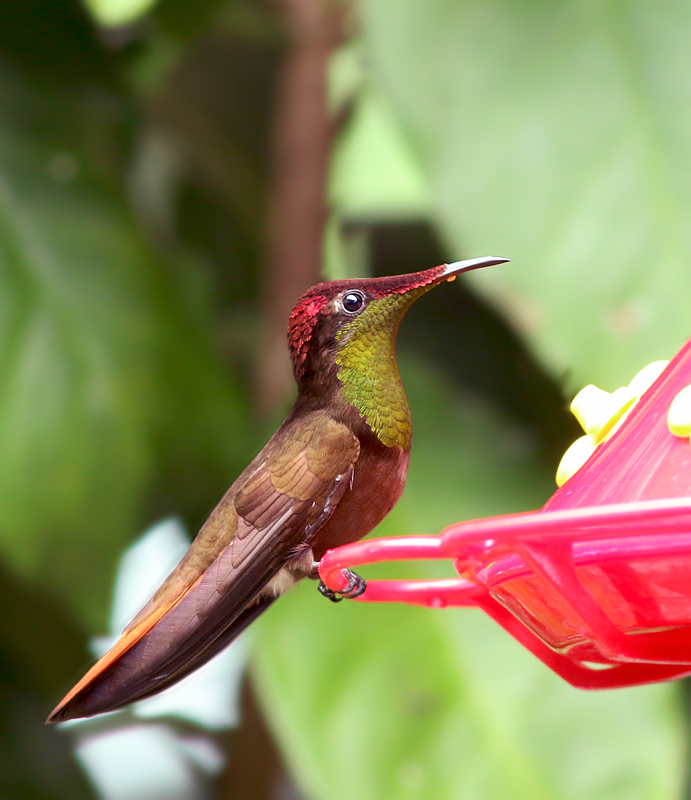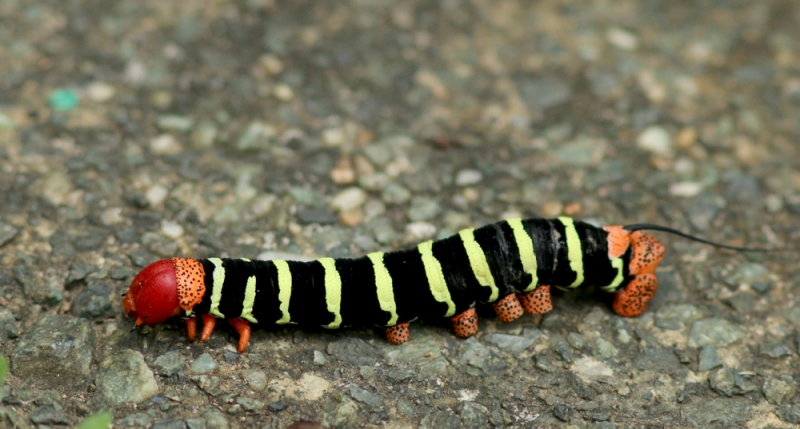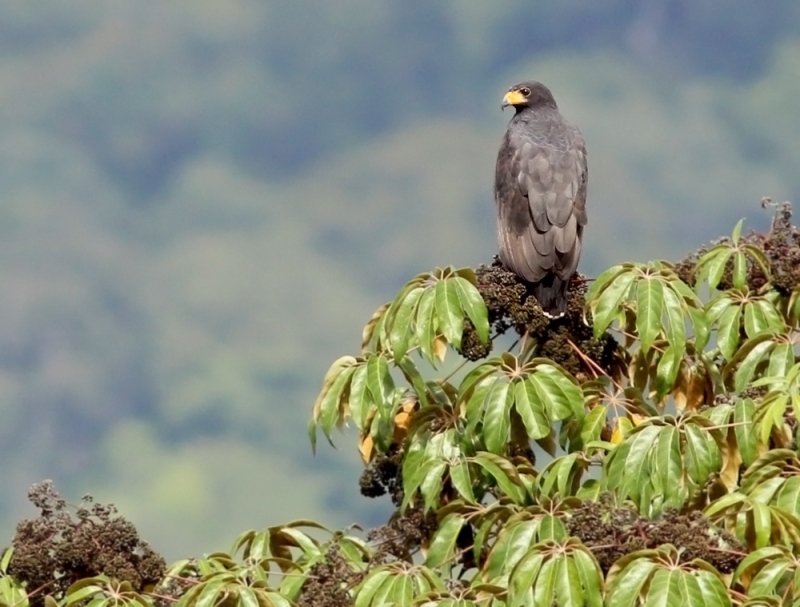** This is the third (and final) installment about the recent Eagle Eye Tours trip I co-led in Trinidad & Tobago (December 2015). Follow these links to read the first and second posts. **
Following an amazing week in Trinidad (see previous posts), we continued our adventure with a quick flight to the neighbouring island of Tobago. Despite its small size, Tobago offers an awesome array of great birding. And, despite its proximity to Trinidad, Tobago also offers a suite of birds that are either absent from or more difficult to find there. These last three days of our tour were a wonderful mix of ocean, wetland, forest edge and rainforest birding!

An iconic seabird, this Red-billed Tropicbird was one of many that we enjoyed during our visit to Tobago. Seeing hundreds of them was one of the major highlights for our entire group!

One of our first stops on Tobago was at a series of settling ponds at a local golf course, where we enjoyed a variety of waders and waterfowl – including our best looks at several Black-bellied Whistling Ducks.

A number of Southern Lapwings were also present, taking advantage of the abundant short grass they like so much.

We also visited a private farm with an beautiful feeder set-up (and the best mango smoothies you can imagine!). Among the many hummingbirds were several classy-looking White-necked Jacobins.

However, the clear highlight (and our main target) was the brilliant Ruby Topaz. I found it impossible to get a photo that truly captured the amazing colours of this bird, but this one comes the closest. The throat absolutely glowed when it caught the sunlight!

The feeders and offering of fresh fruit attracted a variety of visitors – including a pair of Barred Antshrikes. Here, the male enjoys some easy-picking banana.

Personally, I found female Barred Antshrikes to be just as (if not more) attractive than the males. This one seemed to be checking me out, although I doubt I came across as quite so interesting!

Equally intriguing were several very large caterpillars we encountered on the property. One even made its way on the bus by catching a ride on a participant’s shirt! It appears to be a
Frangipani Hawk Moth (Pseudosphinx tetrio) Caterpillar.

Our “base of operations” on Tobago was a small beach resort at the island’s northeast corner. Here, a child plays on the beach in the nearby village of Speyside.

Our motel property offered plenty of great birding. This Tropical Mockingbird was sitting across from our room door almost every time I went outside.

Though a tad noisy at times, it was still neat to see Rufous-vented Chachalacas roaming around the area. Plus, it’s just plain fun to say “chachalaca”!

House Wrens were fairly common in both Trinidad & Tobago, but this tropical race often comes across as quite different from the North American race that many of us are familiar with.

We also enjoyed some really great looks at a Brown-crested Flycatcher on the property. An absolutely great bird to watch!

Red-crowned Woodpecker is fairly widespread on Tobago, but absent in larger Trinidad. We were fortunate to see several during our visit.

One of the biggest highlights of the tour was a visit to the island of Little Tobago (seen here from a hilltop at Speyside). Tons of great birding awaited us after a short boat ride and somewhat adventurous landing!

Co-leader Jody Allair and one of our participants check out an Audubon’s Shearwater, cozy in it burrow. We were very fortunate since they are just arriving back to their breeding sites at this time of year, and this was the first report of the season!

Another great treat was this Trinidad Motomot. This beautiful species is endemic to Trinidad & Tobago, and can be quite secretive as they sit quietly in the shady rainforest. It was a major target for the tour, and this time everyone got a good look.

Another endemic and very special critter is the Ocellated Gecko. In fact, it is thought that this species occurs ONLY on the tiny island of Little Tobago! What a great looking (though small) lizard.

However, the obvious highlight (and our main reason for visiting Little Tobago) was the incredible seabird colony. While seeing hundreds of Red-billed Tropicbirds like this one was amazing, the colony also included both Red-footed and Brown Boobies.

Nearby islands are also home to large colonies of Magnificent Frigatebird, and they could always be found patrolling around Little Tobago looking for a meal to steal!

Co-leader Jody Allair looks back at the village of Speyside and our lodgings from an overlook on Little Tobago.

Back at our motel, a short hike up a nearby trail produced lots of great birds. Among the new ones was a pair of Black-faced Grassquits (male pictured here).

More secretive, though a little more flashy when seen, were several White-flanked Antwrens that we encountered during our walks. This one was unusually cooperative, though still difficult to see in the open for more than a few seconds.

One of my favourite encounters was with this beautiful Tropical Ratsnake (Spilotes pullatus). It easily measured in at over four feet long (and possibly more) … a stunning animal.

It was awesome to watch this snake actively hunting, expertly maneuvering through the tangled branches with ease and surprising speed. No wonder it can sneak up on prey!

At the other end of the spectrum was this very small Shiny Lizard (Gymnophthalmus underwoodi). It seems this species is rarely spotted on Tobago, which is not surprising considering how tiny it was … no more than a few inches long and no bigger than an earthworm. We were very lucky to see it scamper across the trail and try to hide behind some small rocks. At one point, it even took shelter under my shoe!

Yet another species found on Tobago, but not Trinidad, is the rather plain-looking Scrub Greenlet. It is part of the vireo family.

One hot afternoon when the birding was slow, Jody and I made the short trek to Speyside. Along the way we saw the remnant of several old mills that spoke to some of the area’s economic and cultural past.

Our last big outing of the tour was to go birding in the lush rainforests of Tobago’s Main Ridge. These high elevation forests represent the world’s oldest legally protected forest reserves, established for conservation in 1776! We encountered an incredible variety of birds here (most of which were impossible to photograph in the tall, thick and shady surroundings!). Blue-backed Mannikins, Yellow-legged Thrush, White-tailed Sabrewing, and even the very rare (and unexpected) White-throated Spadebill!

This was one amazing tour, shared with an equally amazing group of people. All said, we encountered a tour-record 223 species of birds, an incredible variety of other critters, wonderful people, and tons of stunning scenery. I’m looking forward to an opportunity to go back again soon!
For your chance to enjoy this (or any other) incredible adventure, check out the Eagle Eye Tours website!




















































